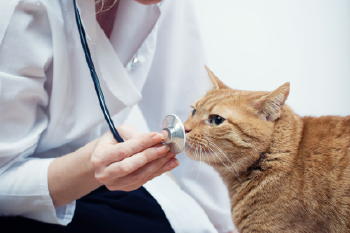Cat Fever

A feline with cat fever will often stop eating and huddle in a miserable lump...even too pooped to purr. Hot internal temperatures could be warning you of cat illnesses. Some felines with a fever also stop drinking, leading to dangerous dehydration. A prolonged fever puts a strain on the heart, brain, and kidneys.
However, fevers have a good
side. By raising body temperature and changing the body's chemistry,
fever can actually defeat some diseases. Fever also helps veterinarians
assess the effectiveness of treatment. Usually, when a fever "breaks"
and a cat's temperature returns to the normal feline range of 100.5 to
102.5 degrees Fahrenheit, it's a sign the cat is on the mend.
When talking about fever, it's important to distinguish true fever (pyrexia) from simple overheating (hyperthermia). While both fever and hyperthermia involve elevated body temperature, in hyperthermia, the animal's hypothalamus...the brain region that acts like a thermometer...is still "set" to a normal temperature. So, the hyperthermic cat feels hot and will attempt to release body heat by panting and finding a cool spot.
But when a cat has a fever, the thermostat in the hypothalamus is reset to a higher temperature. It makes the body think the normal temperature should be 105 or 106 degrees.
So, the body increases heat production and heat conservation by burning energy reserves faster and closing off surface blood vessels (vascoconstriction). A feverish cat may also try to warm itself by shivering and curling into a tight ball.
Usually, a vet can tell whether a cat is hyper-thermic or feverish by asking the owner whether the cat has been in a "hot zone"...such as a car, a closet, or a clothes dryer. If the cat is very hyperthermic, the vet will try to cool it down. But if the cat is feverish, the usual treatment is to leave the fever alone while searching for whatever disease is responsible.
There is no point in trying to cool down a cat with a mild fever because the body is just going to try harder to warm itself up. Occasionally, though, when a fever is prolonged or dangerously high, veterinarians will administer small doses of an anti-fever medication (antipyretic) such as aspirin. But aspirin can be dangerous to cats, so never give your cat this medication without veterinary supervision.
Another reason to leave fevers alone is that a cat fever can help your cat fight disease. When your cat's temperature is above the normal range, invading bacteria and viruses can't replicate as well. Moreover, during a fever, the body has less iron circulating in the blood, and bacteria require this mineral for growth.
Fever also increases the efficiency of your cat's natural defenses. It stimulates the activity of infection-fighting lymphocytes (white blood cells) and phagocytes (cells that eat harmful bacteria) and speeds the production of interferon and interleukin, chemicals that rev up the immune system. Studies have shown there is a higher survival rate among animals that are allowed to experience fever.
While a cat fever is often better left untreated, it should never be ignored. Cat fever can signal a serious illness. Most often, the culprit is an infection by bacteria, viruses, or other microorganisms...although cancers, disorders of the immune system, and non-infectious diseases like hyperthyroidism (an overactive thyroid gland) can also cause cat fever. So, if you discover your cat has an elevated temperature, take your feline buddy to a veterinarian right away.
Taking your cat's temperature is relatively simple. The normal range should be 100.5 - 102.5 degrees Fahrenheit. You probably want to be sure of the cat's temperature rather than submit him to the stress of a car ride (which can elevate his temperature) if you're not sure. Plus, there may be times when you have to monitor your cat's temperature at home during a period of convalescence.
|
| |
To take your cat's temperature, use either a digital thermometer or a glass rectal thermometer (never use an oral one). Some digital thermometers may be used in the ear, but temperatures taken from a cat's ear are usually lower than the cat's actual temperature.
The most accurate way to measure temperature is with a rectal thermometer, (available at such places as Amazon (examples seen above) using the following technique:
- Get a friend or family member to hold your cat's head and shoulders while you perform the task.
- Shake the mercury down to below 96 degrees
- Lubricate the end that will enter the cat with petroleum jelly
- Keep your cat in a standing or crouching position and grasp its tail near the base. Hold the tail halfway up, just enough so you can get a clear view of the anus.
- Insert the thermometer into the anal opening using firm and gentle pressure until about one-third of the thermometer is inside. There will be strong muscular resistance at first but just keep up the same steady but gentle push.
- Leave the thermometer in place for 1 to 2 minutes. If your cat's temperature is over 104 degrees Fahrenheit, contact your vet immediately.
Unfortunately, because cat fever can occur with so many diseases, your vet may need to do a lot of diagnostic work to find the cause. Fevers of unknown origin are one of the most challenging sometimes. Usually, a vet will start with blood and urine tests, which may reveal the presence of infection or another type of disease.
Blood tests can pinpoint FeLV, FIV, toxoplasmosis and other infections. If blood and urine tests fail to reveal a cause, the vet may recommend x-rays or an ultrasound examination to look for abscesses and tumors.
Related Articles......
Return from Cat Fever to Cat Health Homepage
Having trouble finding what you need? Cat Health Index & Site Map
OR
Do you have a question to ask?...Questions
OR
Do you have a cat story to share?...Simply click here to go to that page!
Copyright@2010-2020 All rights reserved.Cat-health-detective.com
This website is information only. Consult a veterinarian for medical assistance

"Like Us" on Facebook
or...
"Like Us" here




















